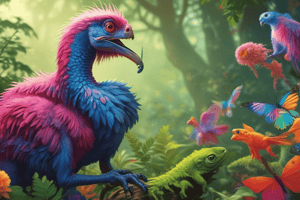Podcast
Questions and Answers
What is an example of a structural adaptation?
What is an example of a structural adaptation?
- Sharp talons used for catching prey
- Fish producing antifreeze proteins
- Thick hair on polar bears for insulation (correct)
- Bird migration during winter
How does variation among individuals of the same species occur?
How does variation among individuals of the same species occur?
- By the mixing of genes during meiosis (correct)
- Through genetic mutations alone
- Due to environmental changes only
- From parental dominance in traits
Which of the following is a behavioral adaptation?
Which of the following is a behavioral adaptation?
- Birds migrating to warmer climates (correct)
- Camouflage in chameleons
- Changes in skin color in response to temperature
- Thick fur on arctic foxes
Which of the following is NOT a requirement for natural selection?
Which of the following is NOT a requirement for natural selection?
What type of evidence does the fossil record provide for evolution?
What type of evidence does the fossil record provide for evolution?
What is a mutation?
What is a mutation?
Which of the following is an example of a biochemical adaptation?
Which of the following is an example of a biochemical adaptation?
Which disease is associated with gradual brain cell degeneration?
Which disease is associated with gradual brain cell degeneration?
What evidence supports the idea that species evolved after the breakup of continents?
What evidence supports the idea that species evolved after the breakup of continents?
What is the primary mechanism by which Charles Darwin proposed that species change over time?
What is the primary mechanism by which Charles Darwin proposed that species change over time?
What kind of features are homologous features?
What kind of features are homologous features?
Which type of isolation occurs when two species breed at different times?
Which type of isolation occurs when two species breed at different times?
What does adaptive radiation refer to?
What does adaptive radiation refer to?
What does speciation require to occur?
What does speciation require to occur?
What are vestigial features?
What are vestigial features?
What does the concept of punctuated equilibrium suggest about evolution?
What does the concept of punctuated equilibrium suggest about evolution?
What distinguishes analogous features from homologous features?
What distinguishes analogous features from homologous features?
Which type of barrier prevents species from interbreeding due to physical separation?
Which type of barrier prevents species from interbreeding due to physical separation?
Flashcards
Structural Adaptation
Structural Adaptation
Physical traits that help an organism survive or reproduce better in its environment.
Natural Selection
Natural Selection
A process where organisms with traits better suited to their environment are more likely to survive and reproduce, passing those traits to their offspring.
Variations
Variations
Differences in traits within a species, like size, color, or behavior.
Mutations
Mutations
Signup and view all the flashcards
Behavioral Adaptation
Behavioral Adaptation
Signup and view all the flashcards
Fossils
Fossils
Signup and view all the flashcards
Chronological Order of Fossils
Chronological Order of Fossils
Signup and view all the flashcards
Biochemical and Body Process Adaptations
Biochemical and Body Process Adaptations
Signup and view all the flashcards
Speciation
Speciation
Signup and view all the flashcards
Transformation
Transformation
Signup and view all the flashcards
Divergence
Divergence
Signup and view all the flashcards
Homologous Features
Homologous Features
Signup and view all the flashcards
Analogous Features
Analogous Features
Signup and view all the flashcards
Vestigial Features
Vestigial Features
Signup and view all the flashcards
Geographical Barriers
Geographical Barriers
Signup and view all the flashcards
Biological Barriers
Biological Barriers
Signup and view all the flashcards
Adaptive Radiation
Adaptive Radiation
Signup and view all the flashcards
Punctuated Equilibrium
Punctuated Equilibrium
Signup and view all the flashcards
Study Notes
Adaptations
- Adaptations are traits that enhance survival and reproduction.
- Biochemical/Body Processes: Internal adaptations like fish producing antifreeze proteins for cold water survival.
- Structural Adaptations: Physical traits like polar bear fur for insulation.
- Behavioral Adaptations: Actions like bird migration for warmer temperatures.
- Examples: Camouflage, hibernation, sharp talons/teeth, good eyesight.
Variations
- Variations are differences in traits within a species (size, color, behavior).
- Cause of Variations: Mixing of parental genes during meiosis results in unique offspring.
- Mutations: Permanent DNA sequence changes.
- Examples of Mutations: Tay-Sachs (nerve cell damage), Huntington's (brain cell death), Cystic Fibrosis (lung/pancreas problems).
Natural Selection
- Natural selection is how populations change due to survival of individuals with beneficial traits.
- Requirements:
- Variation in traits within a population.
- Selective pressure (environment favoring certain traits).
- Heritable traits (passed to offspring).
Evidence for Evolution
- Fossils: Provide evidence of species change over time; simpler organisms appear earlier, more complex later, not all species appear at once.
- Chronological Order: Fossils in younger layers show more recent species.
- Geographic Distribution: Similar species often found in similar geographic areas (evolved after continental separation).
- Anatomy:
- Homologous Structures: Similar structure, different function (e.g., bat, whale, cat forelimbs), indicating common ancestry.
- Analogous Structures: Different structure, similar function (e.g., bird, bat wings), not indicating common ancestry..
- Vestigial Structures: Structures with reduced or lost function (e.g., human appendix, whale hip bones).
- Transitional Fossils: Fossils showing intermediate stages in evolutionary change.
Lamarck
- Lamarck proposed a theory of evolution where acquired traits are inherited.
- Example: a giraffe stretching its neck becomes longer in order to survive, and passes this longer neck on.
Darwin
- Darwin's theory of evolution by natural selection:
- Species change over time because individuals with beneficial traits reproduce more successfully and pass these traits on.
- Darwin's work is based on observations made during his voyage on the HMS Beagle.
Speciation
-
Speciation is the formation of new species.
-
Types:
-
Transformation: One species changing completely into a new species.
-
Divergence: One species splitting into two or more.
-
For speciation to occur: Populations need to be reproductively isolated to prevent gene flow.
-
Types of Isolation:
-
Geographical: Physical barriers preventing interbreeding (mountains, rivers, oceans).
-
Biological: Internal/behavioral factors preventing interbreeding in the same geography.
-
Behavioral isolation: differences in mating behaviors.
-
Habitat isolation: Different habitats even in the same place
-
Temporal Isolation: Reproductive periods differ.
-
Mechanical Isolation: Incompatibility of reproductive structures.
-
Gametic Isolation: Incompatibility of sperm and egg.
-
Adaptive Radiation: Rapid evolution of many species from a single ancestor (e.g. Darwin's Finches).
Pace of Evolution
- Punctuated Equilibrium: Evolution occurs in rapid bursts followed by long periods of little change.
- Gradualism: Evolution happens slowly and steadily.
Studying That Suits You
Use AI to generate personalized quizzes and flashcards to suit your learning preferences.




